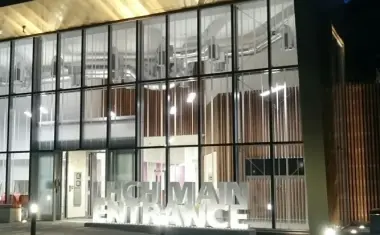Security for Public Transportation: Focus Interview
Genetec, Qognify, Hikvision, and Milestone Systems answer to GIT's questions about public transportation security.

1. What are the biggest challenges in the public transportation sector and what solutions do you recommend to increase transportation?
2. What can users expect from your systems beyond security?
3. Please describe a success case where you have implemented one of your systems in a ‘Public Transportation’ project.
Yavor Gueorguiev, Application Delivery Manager, Intelligent Mobility at Genetec
1. With public transport use now bouncing back to pre-pandemic levels, it’s essential to be able to provide a safer environment for passengers and a quick response when incidents occur. However, when providers first adopted technologies, such as video surveillance, access control and intruder detection, they were typically deployed on a stand-alone basis to address a specific need. That hampers efforts to mount a coordinated response. We recommend the adoption of a unified security platform that breaks down silos, encourages collaboration and facilitates data sharing between security teams and law enforcement.
2. The value of a unified platform is that its applications can quickly extend beyond security to support daily operations and provide an additional source of business intelligence. For example, it’s possible to use people counting and other video analytics to monitor occupancy levels inside the concourse, on platforms and in waiting rooms. Automatic alerts can be generated and a pro-active approach to crowd management can be deployed before a problem escalates. Equally, accurate footfall, people flow and demographic data can be collected and used to help attract retailers and let out commercial space.
3. The Lyon Metro in France has successfully implemented Genetec Security Center to manage its 1,900 cameras across 42 subway stations. It is also seamlessly monitoring the 576 cameras onboard its D-line trains from the same interface. The change has been transformational as it had previously relied on two disconnected systems, meaning they lost real-time visibility of users as soon as they stepped on board a train. It can now offer an enhanced level of passenger safety and support. For example, by having sight of passengers when they press the intercom inside the train. And by providing evidence more quickly to law enforcement should a criminal activity occur.
Dexter Zhu, Public Transportation Solution Manager, at Hikvision
1. For public transportation, safety is the foundation, and efficient operation is the purpose. One challenge for the sector is to ensure safety for both transportation facilities and passengers. To address this, we offer transportation hubs comprehensive security solutions with Hikvision’s scenario-based intelligent algorithm. It not only protects and monitors the key elements in hubs, but also keeps track of any potential anomaly or emergency and instantly triggers alarms, so that the security team can react quickly to any threats or security concerns.
To help achieve constant improvement of operating efficiency, Hikvision provides people counting solution to track passenger flow in both transportation hubs and on-board. Live passenger flow analysis helps to control passenger capacity in case of overload. On the other hand, historical passenger flow data can assist further transportation network planning.
2. With many years of continuous scenario analysis and solution development, what Hikvision can provide is way beyond security. By combining our diversified product family and scenario adapted algorithm, our solutions can help transportation industry in many ways such as safe driving and operational efficiency improvement. For example, our intelligent cabin solution for buses is featured with advanced driving assist, blind spot detection, 360 degree around view monitoring and driver anomaly detection, along with Hikvision’s on-board products embedded with intelligence algorithms. The solution provides 360° views without blind spot, and collision warning for bus driver, which ensures safe driving, reduces accidents, improves bus lane traffic flow, and makes the urban bus system work more efficiently.
3. We have many success cases in multiple industries such as metro, railway, bus, port and airport around the world. For one project, where we unfortunately are not allowed to mention the city, we have worked closely with an industry-leading integrator, and designed and installed video security system with more than 6000 cameras, the access control and other systems in more than 30 stations within the city. The system design includes site cascading, software high availability, remote disaster recovery, cluster storage and ISCS system integration, which provided an integrated system that met the industry RAMS standard for metro system. The system has been running 24/7 for 2 years and the user is satisfied with our stable product and system performance, and are looking to collaborate with us for upcoming metro lanes.
Bjørn Bergqvist, Senior Manager, leading the marketing of Milestone’s solutions for cities
1. By 2050 around 70 % of the world’s population will be living in cities, putting immense pressure on infrastructure. Cities around the world go through substantial changes designed to accommodate this expected growth. As cities grow in area and in population, making it from point A to point B efficiently becomes a challenge for city officials and a priority for residents. Cities are continuously looking for data and insights that can help them plan, invest, and serve their residents more efficiently. Video is present in many cities and local governments are interested in utilizing it to increase their Return on Investment. Video technology and Milestone’s wide range of solutions not only allow decision makers to make better decisions and deploy public transport more effectively, but also to improve the overall customer experience making the journey more pleasant and seamless.
2. For decades, video surveillance has been used almost exclusively for security purposes. Advances in technology, like data processing and video analytics, made it possible to generate insights and not just video from cameras. While the use cases that can benefit from video analytics are many, one area that is already using video technology beyond security is public transportation. Francis Bacon once said that “knowledge is power” and this cannot be truer when it comes to video technology. In large areas, such as in cities, being able to monitor and analyze big amounts of data is key. Qualified manpower is getting harder and more costly to recruit and due to the size of cities, being efficient requires a lot of it. Milestone’s customers can use video technology to learn, analyze, and improve traffic patterns within and between cities, increasing efficiency and taxpayer’s satisfaction. Scenarios, such as cameras that learn traffic patterns and direct passengers to the fastest means of transport, are becoming a reality. Improving business outcomes for our customers is at the heart of everything we do here at Milestone. We are on an exciting journey that is designed to increase value for our customers in safety, efficiency, and satisfaction. Stay tuned.
3. When discussing public transport, most people immediately think about buses and trains designed to ease traffic congestion attributed mostly to ever-increasing privately owned vehicles on the road. Due to its mountainous terrains, the French territory of Réunion Island faced a challenge: how to ease congestion on steep and crowded roads. The solution was a modern cable car conduit that safely mobilizes a thousand passengers an hour, easing the way for inter-city dynamics and economic advancement. Together with our exceptional partners, video technology is used here to plan and run this inspiring project, that offers an effective alternative to using private vehicles, alleviates crowded road traffic conditions, connects several cultural, academic, and societal hubs, sparks economic growth, improves interfaces and links between housing and employment areas, and improves the municipalities’ integrated public transportation network.
Andreas Conrad, Vice President of Marketing, Qognify
1. One of the biggest challenges for the public transport sector is still dealing with the consequences of the pandemic. In many cases, acceptance and usage have not yet returned to pre-pandemic level. At the same time, we are observing a further increase in urbanization and the emergence of megacities worldwide. The result is an increase in traffic - with the well-known negative consequences for quality of life and climate. That is why it is all the more important today to create attractive public transport offers – and attractive not only means affordable but also comfortable, safe and secure to use.
2. Security in public transport is not an isolated issue – it has a direct impact on operations. That’s why our Enterprise Incident Management solutions follow a holistic approach by orchestrating the management of safety, security, or operations related incidents. They do not only create a more secure environment for passengers, but also improve the service quality, e. g. by helping reduce delays or providing more transparent information. This also applies to our video solutions that can leverage advanced integrations, e. g. to measure the occupancy of stations to make traveling more convenient.
3. A recent example of the successful deployment and use of Qognify technology is the VGF (Verkehrsgesellschaft Frankfurt am Main), the operator of the tram and subway network in Germany’s financial capital Frankfurt. As part of a modern, integrated security control center that combines alerting, response and documentation based on an ecosystem of closely integrated solutions, the video surveillance system based on Qognify VMS covers more than 500 camera channels at over 40 stations and locations. The solution is easy to scale and can grow with the customer’s future needs.













